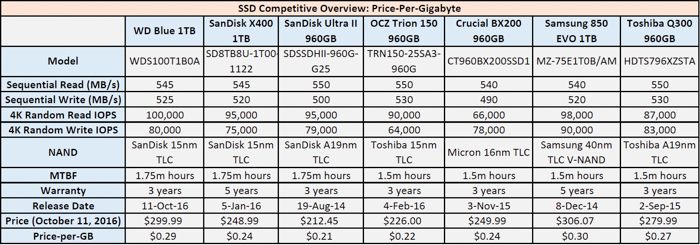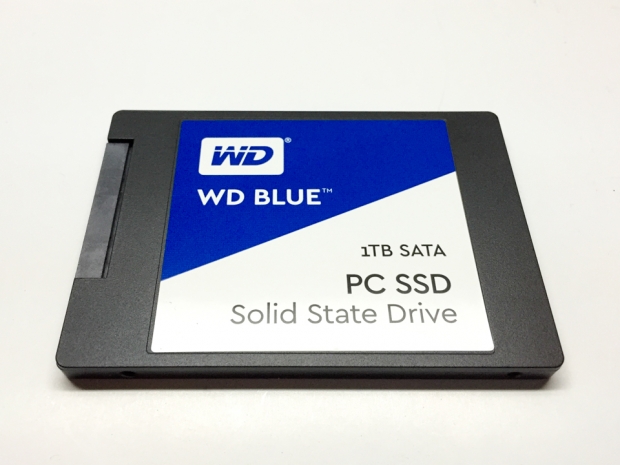Index
Price-per-gigabyte
Most drives in the 1TB SSD market these days have a starting price around $200 on the lower end and can reach about $400 or higher depending on purchase date and any additional markup by the retailer.
SSD Competitive Overview: Price-Per-Gigabyte (Larger image here)
In terms of pricing, the 2.5-inch version of the WD Blue 1TB SSD can be found at Newegg at the MSRP price of $299.99, while the M.2 version is available for $319.99. Amazon has the 2.5-inch version listed for $279.99, but they will not ship it until early November, so we are using Newegg’s price as a reference in our charts. The same goes for B&H, MacMall and TigerDirect, among others.
Our chart lists some of the highest performing solid state drives over the past 30 months, with the SanDisk Ultra II 960GB coming in at a low $212.45 ($0.21 per-gigabyte), followed by the OCZ Trion 150 960GB at $226, and the SanDisk X400 1TB and Crucial BX200 960GB at $248.99 and $249.99, respectively. There is a noticeable $30 price jump to the Toshiba Q300 at $279.99, while at the top of the list are the WD Blue 1TB and Samsung 850 EVO 1TB with similar prices of $299.99 and $306.07, respectively.
Dynamic SLC caching
All of the drives listed in this chart feature SLC caching in one form or another, which allows small temporary amounts of data to be read to and written from DRAM much faster before being stored in the larger TLC NAND flash blocks.
SanDisk’s X400 and Ultra II drives both use advanced flash management features including nCache 2.0, multi-page recovery, XOR recovery and “on chip copy” that uses up to 40GB of SLC storage on the 960GB model to read and write files of any size. In the past, this feature was limited to small 4KB file writes and just 1GB of space on the Ultra Plus series. Samsung’s 850 EVO 1TB and Crucial’s BX200 also use a similar pseudo-SLC caching layer that allow much higher write performance in short bursts, which are handled by their respective Silicon Motion SM2246EN and Samsung MEX controllers. Toshiba calls its form of SLC caching “adaptive size SLC write cache technology,” while OCZ’s implementation is called “Performance Mode” and allocates 1.5 percent, or 14.5GB of storage on the 960GB model as an SLC-like buffer that significantly improves sustained transfer speeds for large datasets.
Western Digital’s implementation is called “tiered SLC caching” and will give the same result, improving sustained write performance for large files as long as the data fits into the SLC cache size.




